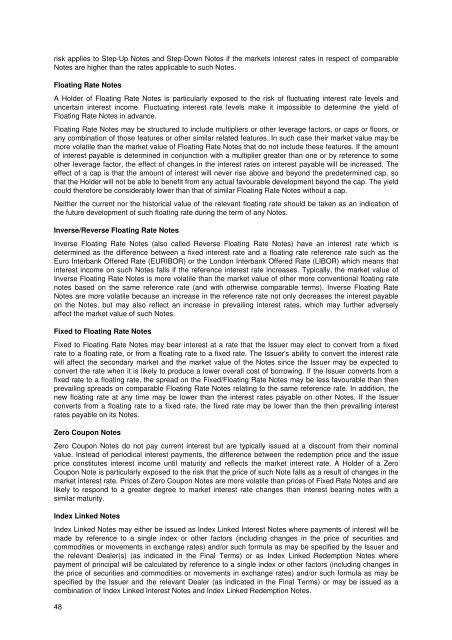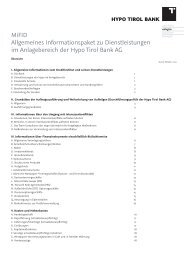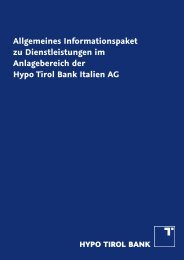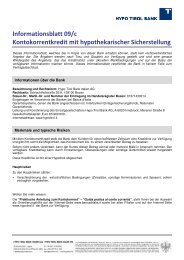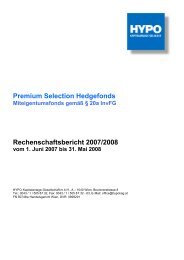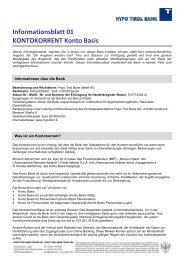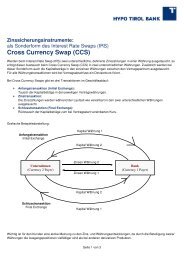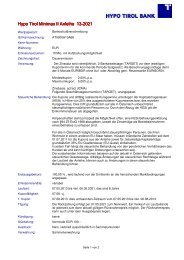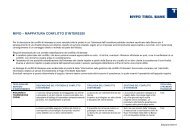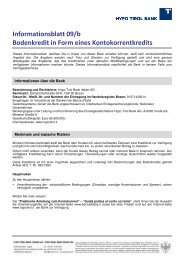isk applies to Step-Up Notes and Step-Down Notes if the markets interest rates in respect of comparableNotes are higher than the rates applicable to such Notes.Floating Rate NotesA Holder of Floating Rate Notes is particularly exposed to the risk of fluctuating interest rate levels anduncertain interest income. Fluctuating interest rate levels make it impossible to determine the yield ofFloating Rate Notes in advance.Floating Rate Notes may be structured to include multipliers or other leverage factors, or caps or floors, orany combination of those features or other similar related features. In such case their market value may bemore volatile than the market value of Floating Rate Notes that do not include these features. If the amountof interest payable is determined in conjunction with a multiplier greater than one or by reference to someother leverage factor, the effect of changes in the interest rates on interest payable will be increased. Theeffect of a cap is that the amount of interest will never rise above and beyond the predetermined cap, sothat the Holder will not be able to benefit from any actual favourable development beyond the cap. The yieldcould therefore be considerably lower than that of similar Floating Rate Notes without a cap.Neither the current nor the historical value of the relevant floating rate should be taken as an indication ofthe future development of such floating rate during the term of any Notes.Inverse/Reverse Floating Rate NotesInverse Floating Rate Notes (also called Reverse Floating Rate Notes) have an interest rate which isdetermined as the difference between a fixed interest rate and a floating rate reference rate such as theEuro Interbank Offered Rate (EURIBOR) or the London Interbank Offered Rate (LIBOR) which means thatinterest income on such Notes falls if the reference interest rate increases. Typically, the market value ofInverse Floating Rate Notes is more volatile than the market value of other more conventional floating ratenotes based on the same reference rate (and with otherwise comparable terms). Inverse Floating RateNotes are more volatile because an increase in the reference rate not only decreases the interest payableon the Notes, but may also reflect an increase in prevailing interest rates, which may further adverselyaffect the market value of such Notes.Fixed to Floating Rate NotesFixed to Floating Rate Notes may bear interest at a rate that the Issuer may elect to convert from a fixedrate to a floating rate, or from a floating rate to a fixed rate. The Issuer's ability to convert the interest ratewill affect the secondary market and the market value of the Notes since the Issuer may be expected toconvert the rate when it is likely to produce a lower overall cost of borrowing. If the Issuer converts from afixed rate to a floating rate, the spread on the Fixed/Floating Rate Notes may be less favourable than thenprevailing spreads on comparable Floating Rate Notes relating to the same reference rate. In addition, thenew floating rate at any time may be lower than the interest rates payable on other Notes. If the Issuerconverts from a floating rate to a fixed rate, the fixed rate may be lower than the then prevailing interestrates payable on its Notes.Zero Coupon NotesZero Coupon Notes do not pay current interest but are typically issued at a discount from their nominalvalue. Instead of periodical interest payments, the difference between the redemption price and the issueprice constitutes interest income until maturity and reflects the market interest rate. A Holder of a ZeroCoupon Note is particularly exposed to the risk that the price of such Note falls as a result of changes in themarket interest rate. Prices of Zero Coupon Notes are more volatile than prices of Fixed Rate Notes and arelikely to respond to a greater degree to market interest rate changes than interest bearing notes with asimilar maturity.Index Linked NotesIndex Linked Notes may either be issued as Index Linked Interest Notes where payments of interest will bemade by reference to a single index or other factors (including changes in the price of securities andcommodities or movements in exchange rates) and/or such formula as may be specified by the Issuer andthe relevant Dealer(s) (as indicated in the Final Terms) or as Index Linked Redemption Notes wherepayment of principal will be calculated by reference to a single index or other factors (including changes inthe price of securities and commodities or movements in exchange rates) and/or such formula as may bespecified by the Issuer and the relevant Dealer (as indicated in the Final Terms) or may be issued as acombination of Index Linked Interest Notes and Index Linked Redemption Notes.48
If payment of interest is linked to a particular index, a Holder of an Index Linked Interest Note is particularlyexposed to the risk of fluctuating interest rate levels and uncertain interest income or may even receive nointerest at all which may have the effect that the yield of an Index Linked Interest Note is negative. Ifpayment of principal is linked to a particular index, a Holder of an Index Linked Redemption Notes isparticularly exposed to the risk that the redemption amount is uncertain. Depending on the calculation of theredemption amount, the yield of an Index Linked Redemption Note may be negative and the investor mightlose the value of its entire investment or parts of it. The Issuer has no control over a number of matters,including economic, financial and political events that are important in determining the existence, magnitudeand longevity of these risks and their results.Investors should be aware that the market price of Index Linked Notes may be very volatile (depending onthe volatility of the relevant index). Neither the current nor the historical value of the relevant index shouldbe taken as an indication of the future performance of such index during the term of any Note. The morevolatile the relevant index is, the greater is the volatility of the market price of such Note and the uncertaintyin respect of interest income and redemption amount. Uncertainty with respect to interest and redemptionamount makes it impossible to determine the yield of Index Linked Notes in advance.General Risks in respect of Structured NotesAn investment in Notes by which the premium and/or the interest on and or principal of which is determinedby reference to one or more values of currencies, commodities, interest rates or other indices or formulae,either directly or inversely, may entail significant risks not associated with similar investments in aconventional debt security including the risks that the Holder of such Note will receive no interest at all, thatthe resulting interest rate will be less than that payable on a conventional debt security at the same timeand/or that an investor could lose all or a substantial portion of the principal of his Notes. In addition,investors should be aware that the market price of such Notes may be very volatile (depending on thevolatility of the relevant currency, commodity, interest rate, index or formula).Neither the current nor the historical value of the relevant currencies, commodities, interest rates or otherindices or formulae should be taken as an indication of future performance of such currencies, commodities,interest rates or other indices or formulae during the term of any Note.Risks in connection with CapsIf the interest rate and/or redemption amount of an issue of Notes are not fixed but will be determinedaccording to the structure of the Notes as set out in the Final Terms, these issues may also be equippedwith a cap. The effect of a cap is that the amount of interest and/or the redemption amount will never riseabove and beyond the predetermined cap, so that the Holder of Notes will not be able to benefit from anyactual favourable development beyond the cap. The yield could therefore be considerably lower than that ofsimilarly structured Notes without a cap.Equity Linked NotesEquity Linked Notes may either be issued as Equity Linked Interest Notes where payment of interest will becalculated by reference to a single equity security or a basket of equity securities (as indicated in the FinalTerms) or as Equity Linked Redemption Notes where payment of principal will be calculated by reference toa single equity security or a basket of equity securities (as indicated in the Final Terms). Equity LinkedRedemption Notes may also provide that the redemption will be by physical delivery of reference items.Accordingly, an investment in Equity Linked Redemption Notes may bear similar risks as a direct equityinvestment and investors should take advice. In case of Equity Linked Redemption Notes, the investor maylose the value of his entire investment or part of it.Credit Linked NotesAn investment in Credit Linked Notes involves a high degree of risk. A Holder of a Credit Linked Note isexposed to the credit risk of the Issuer and that of one or more reference entities or assets (as specified inthe Final Terms). There is no guarantee that the Holders of such Notes will receive the full principal amountof the Notes and interest thereon and ultimately the obligations of the Issuer to pay principal under theNotes may even be reduced to zero.In the event of the occurrence of a credit event (as specified in the Final Terms) such as bankruptcy, failureto pay obligations, accelerations and repudiation/moratorium in respect of one or more reference entities orassets, the Issuer may redeem the Notes either by delivering to the Holders of the Notes such "deliverableobligations" (as specified in the Final Terms) of any such reference entity in respect of which the creditevent has occurred, or, if cash settlement is specified in the Final Terms, by the payment of an amount of49
- Page 1 and 2: This document constitutes two base
- Page 4 and 5: Table of ContentsPageSummary ......
- Page 6 and 7: SummaryThe following constitutes th
- Page 8 and 9: NotesInstalment NotesIndex Linked N
- Page 10 and 11: from payments of principal or inter
- Page 12 and 13: STATUTORY AUDITORSSummary regarding
- Page 14 and 15: In this business year, the interest
- Page 16 and 17: Dr. Toni Ebner, Second Deputy to th
- Page 18 and 19: Members delegated by the StaffCommi
- Page 20 and 21: MATERIAL CONTRACTSThere are no mate
- Page 22 and 23: Note may be negative. The more vola
- Page 24 and 25: German Translation of the SummaryDe
- Page 26 and 27: entspricht, die durch einen Vertrag
- Page 28 and 29: mehrerer solcher Instrumente bezieh
- Page 30 and 31: Verbindlichkeiten der Emittentin, d
- Page 32 and 33: Zusammenfassung in Bezug auf die HY
- Page 34 and 35: im Vorjahr merklich durch die Risik
- Page 36 and 37: Dr. Toni Ebner, 2.Vorsitzender Stel
- Page 38 and 39: 23.11.2007 gemeinsam mit einem weit
- Page 40 and 41: Zusammenfassung der Risikofaktoren
- Page 42 and 43: FinanzmarktkriseSeit Mitte des Jahr
- Page 44 and 45: 44General Description of the Progra
- Page 46 and 47: Risk FactorsRisk Factors regarding
- Page 50 and 51: cash as determined in accordance wi
- Page 52 and 53: HYPO TIROL BANK AGSTATUTORY AUDITOR
- Page 54 and 55: In this business year, the interest
- Page 56 and 57: Dr. Toni Ebner, Second Deputy to th
- Page 58 and 59: Members delegated by the StaffCommi
- Page 60 and 61: FINANCIAL INFORMATION RELATING TO T
- Page 62 and 63: Consolidated statement of cash flow
- Page 64 and 65: Liabilitiesin EUR 1,000 30.06.2011
- Page 66 and 67: ISSUE PROCEDURESfor Notes in Bearer
- Page 68 and 69: Terms and Conditions of the NotesEn
- Page 70 and 71: [In the case the Global Note is a N
- Page 72 and 73: (iv)(v)The set-off of the repayment
- Page 74 and 75: "Interest Determination Date" means
- Page 76 and 77: [In the case of Instalment Notes, s
- Page 78 and 79: Instalment Date(s)Instalment Amount
- Page 80 and 81: (a) For purposes of subparagraph (2
- Page 82 and 83: § 9EVENTS OF DEFAULT(1) Events of
- Page 84 and 85: (3) Change of References. In the ev
- Page 86 and 87: asis of (i) a statement issued by t
- Page 88 and 89: und verwandten Schuldverschreibunge
- Page 90 and 91: applied to the last preceding Inter
- Page 92 and 93: § 4PAYMENTS(1) [(a)] Payment of Pr
- Page 94 and 95: [If the Fiscal Agent is to be appoi
- Page 96 and 97: These Terms and Conditions are writ
- Page 98 and 99:
on which the Notes may be redeemed
- Page 100 and 101:
B. PFANDBRIEFE IN REGISTERED FORMTh
- Page 102 and 103:
appointment or change shall only ta
- Page 104 and 105:
104Teil I - GRUNDBEDINGUNGENA. ANLE
- Page 106 and 107:
Schuldverschreibungen zur gleichen
- Page 108 and 109:
(ii)(iii)(iv)Zinsen dürfen auf die
- Page 110 and 111:
Prozent, wobei 0,000005] aufgerunde
- Page 112 and 113:
[Falls Actual/Actual (ISDA) anwendb
- Page 114 and 115:
(2) Vorzeitige Rückzahlung aus ste
- Page 116 and 117:
[(5)] Vorzeitiger Rückzahlungsbetr
- Page 118 and 119:
118Republik Österreich oder die Eu
- Page 120 and 121:
§ [10]ERSETZUNG(1) Ersetzung. Die
- Page 122 and 123:
Emittentin eine Veröffentlichung n
- Page 124 and 125:
B. ANLEIHEBEDINGUNGENFÜR AUF DEN I
- Page 126 and 127:
Monate][andere festgelegte Zeiträu
- Page 128 and 129:
diesem Zeitpunkt notiert sind und d
- Page 130 and 131:
[im Fall von Raten-Schuldverschreib
- Page 132 and 133:
(3) Beauftragte der Emittentin. Die
- Page 134 and 135:
134TEIL II - ZUSÄTZE ZU DEN GRUNDB
- Page 136 and 137:
[falls der Gläubiger ein Wahlrecht
- Page 138 and 139:
B. NAMENSPFANDBRIEFEDie unten aufge
- Page 140 and 141:
§ 6DIE EMISSIONSSTELLE [,] [UND] D
- Page 142 and 143:
DESCRIPTION OF RULES REGARDING RESO
- Page 144 and 145:
In case of Notes listed on the offi
- Page 146 and 147:
Part I.: Terms and ConditionsTeil I
- Page 148 and 149:
Aggregate Principal Amount [ ]Gesam
- Page 150 and 151:
INTEREST (§ 3)ZINSEN (§ 3) Fixed
- Page 152 and 153:
Maximum Rate of Interest [ ] per ce
- Page 154 and 155:
Minimum Notice to Holders 18 [ ]Min
- Page 156 and 157:
Austria (Amtsblatt zur Wiener Zeitu
- Page 158 and 159:
Securities Identification NumbersWe
- Page 160 and 161:
are most evident 39Umfassende Erlä
- Page 162 and 163:
subscription rights and the treatme
- Page 164 and 165:
Name und Anschrift der Institute, d
- Page 166 and 167:
TaxationThe following is a general
- Page 168 and 169:
Other TaxesNo stamp, issue, registr
- Page 170 and 171:
If interest payments are made by a
- Page 172 and 173:
Under the Luxembourg laws of 21 Jun
- Page 174 and 175:
an application of any third party,
- Page 176 and 177:
Rules") (or, after 18 March 2012, a
- Page 178 and 179:
General InformationCovered Bonds"Co
- Page 180 and 181:
Documents incorporated by Reference
- Page 182 and 183:
ADDRESSESIssuerHYPO TIROL BANK AGMe


